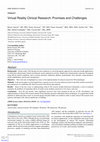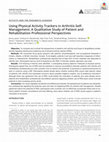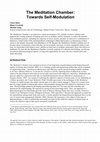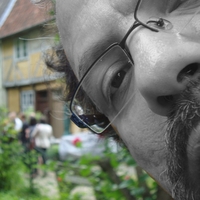Talks by Dr.Diane Gromala

Permeable Bodies: Bacteria and Indeterminate Embodiment
In Cary Wolfe's "What is Posthumanism?" embodiment is central to the posthuman shift away from an... more In Cary Wolfe's "What is Posthumanism?" embodiment is central to the posthuman shift away from anthropocentric understandings of the world. For Wolfe, embodiment is a way of recognizing the radical difference between different animal bodies (human and non-human) that leads to a heterogeneity of being-in-the-world, inextricably linked to the specificity of particular bodily forms and capacities. This culminates in a new conception of posthuman bioethics, grounded in embodiment. In this paper, I expand upon Wolfe's theories through a consideration of the embodied hybridity expressed in human-bacteria symbiosis.
A brief review of human-bacteria relationships begins to weaken conceptions of human embodiment as distinctly whole: there are 10 times the number of bacteria cells as human cells on the body, bacteria of the gut extend the human body's ability to breakdown and digest food, bacteria affect mood, immunity, and other physiological processes and development. Bacteria also use complex forms of inter- and intraspecies communication. In short, the bacteria within play central roles in human existence and experience and align with other posthuman articulations of cyborgs, cybernetics, and network societies where dynamic relationships between systems and environments trump essentialist categorization.
As many have argued, posthumanism dismantles conceptions of human centrality and superiority. Relational conceptions of embodiment found in human-bacteria symbiosis reveals a permeable connection to the world allowing for a shift away from human centrality, through a prosthetic extension of bodily capacity.

Material Posthumanism: (Re)Configurations of Practice
The discursive and material practices of science and art offer particular ways of understanding b... more The discursive and material practices of science and art offer particular ways of understanding brought about through specific configurations of forces, to paraphrase Bruno Latour. These disciplines are often seen as dichotomous practices of representation that shape our understanding and experience of the world. However, maintaining ghettoized distinctions between science and art only continues a reifying process that limits potential connections. It maintains the status quo of configurations, disrupting the immanent connections of dynamic assemblages. Synthetic biology, in its current nascent form, offers an opportunity to explore the becomings of such an assemblage. The DIYers, biohackers, scientists and artists who practice within this realm form permeable configurations of ad hoc institutions unburdened by the limitations of a distinct set of disciplinary categorizations.
This paper will investigate the material practices of these ad hoc configurations, looking for the new modes of production and meaning-making that they bring forth. Posthuman ethics, theories and aesthetics will guide a survey of four different projects, including a work-in-progress by the author, exploring biological considerations of material posthumanism.
Papers by Dr.Diane Gromala
Can a multifaceted wearable-based program improve physical activity participation in people with knee osteoarthritis? A proof-of-concept randomized controlled trial
JMIR mHealth and uHealth: Mobile and tablet apps, ubiquitous and pervasive computing, wearable computing, and domotics for health. , 2020

The Meditation Chamber: Towards Self-Modulation
Metaplasticity in Virtual Worlds: Aesthetics and Semantics Concepts, 2011
The Meditation Chamber is an immersive virtual environment (VE), initially created to enhance and... more The Meditation Chamber is an immersive virtual environment (VE), initially created to enhance and augment the existing methods of training users how to meditate, and by extension, to realize the benefits from meditation practice, including the reduction of stress, anxiety and pain. Its innovative combination of immersive virtual reality (VR) and biofeedback technologies added interoceptive or dimensions of inner senses to the already sensorially rich affordances of VR. Because the Meditation Chamber enabled users to become aware of autonomic senses that they are not normally conscious of, and to manipulate them in real-time, we found that it did enhance users’ abilities to learn how to meditate, particularly those who had never meditated. We describe the Meditation Chamber, scientific methods of evaluation and findings, and discuss first-person phenomenological aspects, its long-term applicability for users who have chronic pain, and future directions.
Virtual Reality as Analgesia: An Alternative Approach for Managing Chronic Pain
IGI journal Creative Interfaces and Computer Graphics, 2014
This paper introduces a multidisciplinary and interactive approach to self-management of chronic ... more This paper introduces a multidisciplinary and interactive approach to self-management of chronic pain using Virtual Reality VR. This approach is meant to reduce the reliance on heavy use of medication and provide a non-pharmacological method for pain management. In addition, the paper discusses additional technologies that deal with issues surrounding immersion, presence, and interface design that directly impact the quality of treatment patients can obtain through VR therapy. A set of guidelines are also included that signify the importance of using biofeedback and interactive sound design to help improve rehabilitation and meditation practices for pain reduction.

Improving the Mental State of Patients in Clinical Settings Using a Non-pharmacological Method
Pervasive Computing Paradigms for Mental Health, 2014
Over the past two decades, a shift and rethinking has occurred by placing focus on patient-center... more Over the past two decades, a shift and rethinking has occurred by placing focus on patient-centered care. In 2001, the Institute of Medicine included patient-centered care as 1 of 6 specific aims at improving and bridging the quality, effectiveness, and efficiency of care required for patients. However, one area that patient-centered care has failed to clearly address is the psychological experience of patients waiting in clinics. In this paper, we address such psychological factors that impact patients and introduce a novel approach that has the potential for reducing stress and anxiety while waiting in clinical environments. Through this approach, we attempt at answering the following questions: Since patients might experience anxiety and stress while waiting, can a perceptual change in the environment help minimize such level of discomfort? And furthermore, can such a stress-reduction approach assist patients in communicating their symptoms more clearly to doctors?

A Field Study: Evaluating Gamification Approaches for Promoting Physical Activity with Motivational Models of Behavior Changes
Human-Computer Interaction. Novel User Experiences, 2016
Wearable trackers and mobile applications can facilitate self-reflection of doing physical activi... more Wearable trackers and mobile applications can facilitate self-reflection of doing physical activity. The gamification process incorporates game design elements with persuasive systems in order to encourage more physical activity. However, few gamification strategies have been rigorously evaluated; these investigations showed that using the same gamification mechanism to promote physical activity could have contradictory effects. Therefore, I developed FitPet, a virtual pet-keeping mobile game for encouraging activity. I evaluated its effectiveness, and compared it with the goal-setting and social community strategies in a six-week field study. The findings revealed social interaction were the most effective intervention. Contrary to prior research, goal-setting was not perceived as an effective way to provide motivation compared to social interaction overall. Although FitPet was not able to promote significantly higher activity, participants showed great interests in this approach and provided design insights for future research: implementing social components and more challenging gameplay.

Players’ Experience of an Augmented Reality Game, Pokémon Go: Inspirations and Implications for Designing Pervasive Health Gamified Applications.
HCII, 2017
Pokémon Go is a mobile Augmented Reality (AR) game that blends gameplay with real-life outdoor ph... more Pokémon Go is a mobile Augmented Reality (AR) game that blends gameplay with real-life outdoor physical activity. In this game, players locate, catch and interact with virtual creatures called Pokémon. Initial reports and online players’ statistics suggest that Pokémon Go motivates players to go outside and become more active. This paper describes an online survey we designed and conducted with players from varied locations and different backgrounds. The goal was to gain initial insight about WHY players spend time on this game and WHAT are their primary motivations; WHEN and HOW they play the game; and WHAT potential changes in physical activity Pokémon Go may elicit from players. Free-to-play, location-based AR mobile games like Pokémon Go are likely to become a new design model for gamified applications that promote physical activity. However, our results imply that in order to sustain motivation and physical activity, the core gameplay and mechanics require thoughtful and engaging design. Further long-term research is needed to understand the benefits and concerns of the game.

JMIR Serious Games, 2018
Objective: This work aims to highlight key issues in the implementation of clinical research for ... more Objective: This work aims to highlight key issues in the implementation of clinical research for VR technologies.
Methods: A discussion paper was developed from a narrative review of recent clinical research in the field, and the researchers’
own experiences in conducting VR clinical research with chronic pain patients.
Results: Some of the key issues in implementing clinical VR research include theoretical immaturity, a lack of technical
standards, the problems of separating effects of media versus medium, practical in vivo issues, and costs.
Conclusions: Over the last decade, some significant successes have been claimed for the use of VR. Nevertheless, the
implementation of clinical VR research outside of the laboratory presents substantial clinical challenges. It is argued that careful
attention to addressing these issues in research design and pilot studies are needed in order to make clinical VR research more
rigorous and improve the clinical significance of findings.
Automatic Pain Level Classification with Physiological Signals using Machine Learning
Canadian Journal of Pain, 2018

Arthritis Care & Research, 2018
Objective. To compare and contrast the perspectives of patients with arthritis and those of rehab... more Objective. To compare and contrast the perspectives of patients with arthritis and those of rehabilitation professionals regarding starting and sustaining use of physical activity trackers (PATs). Methods. We conducted focus group sessions with patients, physiotherapists, and occupational therapists in Ontario, Alberta, or British Columbia, Canada. To be eligible, patients must have self-reported a diagnosis of inflam-matory or osteoarthritis. Rehabilitation professionals reported that at least 40% of their caseload was dedicated to arthritis care. Participants had any level of experience with PATs. A thematic analytic approach was used. Results. The following 3 themes were identified: 1) anticipating sharing objective measures of physical activity. Participants agreed that use of PATs had the potential to improve consultations between patients with arthritis and rehabilitation professionals but were uncertain how to achieve this potential; 2) perceived or experienced barriers to start or continue using a PAT. Participants shared doubts about whether existing PATs would meet specific needs of patients with arthritis and expressed concerns about possible negative impacts; and 3) bolstering motivation? Although there was agreement that use of PATs could bolster the motivation of patients who were already active, patients and rehabilitation professionals had different opinions regarding whether use of PATs alone would motivate patients to start increasing activity levels. Conclusion. Our study highlights similarities and differences between the perspectives of patients and rehabilitation professionals regarding the potential value and risks of integrating PATs into arthritis self-management. Despite agreement about the potential of PATs, participants were uncertain how to effectively incorporate these tools to enhance patient-clinician consultations and had differing views about whether use of PATs would support a patient's motivation to be active.
Virtual Reality (VR) Health Care: Best Practices for Clinical Implementation
AIMed (Artificial Intelligence in Medicine), 2018
A Serious Immersive Reality Game for Promoting Chronic Arthritis Pain Patients' General Physical Activity and Range of Motion.
Canadian Journal of Pain, 2019
Exploring the roles of body ownership, vision and virtual reality on heat pain threshold
Canadian Journal of Pain, 2020
Serious game for serious disease: Diminishing stigma of depression via game experience
2015 IEEE Games Entertainment Media Conference (GEM), 2015
Encouraging physical activity with a game-based mobile application: FitPet
2015 IEEE Games Entertainment Media Conference (GEM), 2015
Digital Arts and Culture 2009, Dec 12, 2009
This paper brings together multiple theories regarding the role of the senses in the construction... more This paper brings together multiple theories regarding the role of the senses in the construction of embodied experiences. Embodiment, we suggest, is not a visual or auditory phenomenon, but rather an ontological one, that is, one of being. Employing accounts from cognitive science, existential phenomenology, and interactive art, we argue that the inner senses have a special role in the construction of these ontological experiences.
Portable Presence: Can Mobile Games Be Immersive Games?
Mobile games – in particular, games played on smartphones and tablet computers – are becoming inc... more Mobile games – in particular, games played on smartphones and tablet computers – are becoming increasingly popular. Yet, there has been little research into whether players can experience immersion while playing mobile games. As the potential for immersive mobile games would be of interest to game developers, researchers and players, it is proposed to measure mobile immersion by comparing Osmos, a multi-platform ambient video game, on three different-sized devices – a smart phone, a tablet and a desktop computer.

The Meditation Chamber is an immersive virtual environment (VE), initially created to enhance and... more The Meditation Chamber is an immersive virtual environment (VE), initially created to enhance and augment the existing methods of training users how to meditate, and by extension, to realize the benefits from meditation practice, including the reduction of stress, anxiety and pain. Its innovative combination of immersive virtual reality (VR) and biofeedback technologies added interoceptive or dimensions of inner senses to the already sensorially rich affordances of VR. Because the Meditation Chamber enabled users to become aware of autonomic senses that they are not normally conscious of, and to manipulate them in real-time, we found that it did enhance users' abilities to learn how to meditate, particularly those who had never meditated. We describe the Meditation Chamber, scientific methods of evaluation and findings, and discuss first-person phenomenological aspects, its long-term applicability for users who have chronic pain, and future directions.











Uploads
Talks by Dr.Diane Gromala
A brief review of human-bacteria relationships begins to weaken conceptions of human embodiment as distinctly whole: there are 10 times the number of bacteria cells as human cells on the body, bacteria of the gut extend the human body's ability to breakdown and digest food, bacteria affect mood, immunity, and other physiological processes and development. Bacteria also use complex forms of inter- and intraspecies communication. In short, the bacteria within play central roles in human existence and experience and align with other posthuman articulations of cyborgs, cybernetics, and network societies where dynamic relationships between systems and environments trump essentialist categorization.
As many have argued, posthumanism dismantles conceptions of human centrality and superiority. Relational conceptions of embodiment found in human-bacteria symbiosis reveals a permeable connection to the world allowing for a shift away from human centrality, through a prosthetic extension of bodily capacity.
This paper will investigate the material practices of these ad hoc configurations, looking for the new modes of production and meaning-making that they bring forth. Posthuman ethics, theories and aesthetics will guide a survey of four different projects, including a work-in-progress by the author, exploring biological considerations of material posthumanism.
Papers by Dr.Diane Gromala
Methods: A discussion paper was developed from a narrative review of recent clinical research in the field, and the researchers’
own experiences in conducting VR clinical research with chronic pain patients.
Results: Some of the key issues in implementing clinical VR research include theoretical immaturity, a lack of technical
standards, the problems of separating effects of media versus medium, practical in vivo issues, and costs.
Conclusions: Over the last decade, some significant successes have been claimed for the use of VR. Nevertheless, the
implementation of clinical VR research outside of the laboratory presents substantial clinical challenges. It is argued that careful
attention to addressing these issues in research design and pilot studies are needed in order to make clinical VR research more
rigorous and improve the clinical significance of findings.
A brief review of human-bacteria relationships begins to weaken conceptions of human embodiment as distinctly whole: there are 10 times the number of bacteria cells as human cells on the body, bacteria of the gut extend the human body's ability to breakdown and digest food, bacteria affect mood, immunity, and other physiological processes and development. Bacteria also use complex forms of inter- and intraspecies communication. In short, the bacteria within play central roles in human existence and experience and align with other posthuman articulations of cyborgs, cybernetics, and network societies where dynamic relationships between systems and environments trump essentialist categorization.
As many have argued, posthumanism dismantles conceptions of human centrality and superiority. Relational conceptions of embodiment found in human-bacteria symbiosis reveals a permeable connection to the world allowing for a shift away from human centrality, through a prosthetic extension of bodily capacity.
This paper will investigate the material practices of these ad hoc configurations, looking for the new modes of production and meaning-making that they bring forth. Posthuman ethics, theories and aesthetics will guide a survey of four different projects, including a work-in-progress by the author, exploring biological considerations of material posthumanism.
Methods: A discussion paper was developed from a narrative review of recent clinical research in the field, and the researchers’
own experiences in conducting VR clinical research with chronic pain patients.
Results: Some of the key issues in implementing clinical VR research include theoretical immaturity, a lack of technical
standards, the problems of separating effects of media versus medium, practical in vivo issues, and costs.
Conclusions: Over the last decade, some significant successes have been claimed for the use of VR. Nevertheless, the
implementation of clinical VR research outside of the laboratory presents substantial clinical challenges. It is argued that careful
attention to addressing these issues in research design and pilot studies are needed in order to make clinical VR research more
rigorous and improve the clinical significance of findings.